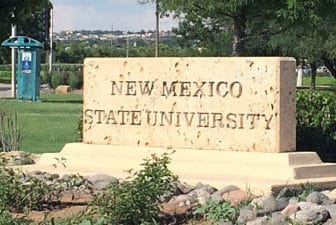New Mexico State University, which already cut its budget by millions of dollars earlier this year, doesn’t plan to seek a mid-year tuition increase even if the state cuts higher education funding to balance its budget.

Heath Haussamen / NMPolitics.net
The New Mexico State University sign at the corner of Union Avenue and Sam Steele Way in Las Cruces.
“We won’t ask the NMSU Board of Regents to consider raising tuition in the middle of the academic year,” university spokesman Justin Bannister said. “We feel pretty confident that we’ll be able to make it through this fiscal year.”
That’s in part because NMSU padded its earlier cuts with an extra $1.5 million in anticipation of another possible reduction in state funding.
The state already cut higher-education funding by 2 percent earlier this year. The University of New Mexico and many other public colleges raised tuition to help cover their shortfalls. NMSU’s Board of Regents rejected a tuition increase, with Student Regent Amanda López Askin calling that action “a very deliberate breaking of a cycle.”
Because of the state funding reduction, declining enrollment, and other issues, NMSU instead made cuts that included eliminating jobs, reducing employee benefits, and pay cuts for some top administrators to trim $12.1 million from its budget.
UNM, meanwhile, is looking at making cuts now to prepare for another reduction in state funding. Its president announced a hiring freeze on Thursday and directed administrators to prepare for a 5 percent funding reduction.
The newest revenue projections leave the state short almost $600 million to pay outstanding bills from the last fiscal year and fund its budget for the current year that began July 1. Lawmakers and Gov. Susana Martinez’s administration are discussing holding a special session to take money from the $219 million Tobacco Permanent Fund to address the shortfall. But that’s not nearly enough. And Martinez says tax increases are off the table.
So additional cuts are likely. Because universities can raise tuition to help cover shortfalls, many expect policymakers to force higher education to shoulder some of the burden.
Beyond the current fiscal year, the state’s long-term outlook is also bleak. Bannister said NMSU’s administration plans to ask the Regents to raise tuition before the start of the next academic year that begins in August 2017.
There’s some indication that the NMSU Regents’ recent resistance to tuition hikes could change over time.
“I voted no on tuition increase this year. I vote no on tuition increase last year, and the reason I did was because I didn’t feel like we were all in the game,” Regent Mike Cheney said at the Board’s July 13 meeting. “Now I’m starting to see some of the conversations emerge to where I’m starting to feel like, you know what, students are willing to give in terms of an increase in tuition, I’ll bet you.”
A 1 percent tuition increase at NMSU would bring in roughly $1 million, so if NMSU had raised tuition 5 percent this year it still would have had to cut about $7 million from its budget.
“These are tough decisions,” Cheney said. “It needs to be a multifaceted approach to the answer.”
Regents who govern NMSU and UNM met in a joint session on Saturday in Las Cruces. They heard from NMSU economist Jim Peach, who said he has “mixed feelings” about raising tuition.
“I actually think college education in the United States should be free to the kids,” Peach said. “… I think we should find alternative mechanisms for funding higher education.”
But in the short term, he pointed out, “we’re hurting and we have an environment in which there are no new revenue sources.” NMSU could face an additional state funding cut of 5 or 6 percent this fiscal year, he said, “and that too will hurt students, and it will hurt the services we provide, it will endanger more programs.”
New Mexico’s economy is largely dependent on fluctuating oil and gas revenues, so the state cycles between years with surpluses and years with less money.
To make matters worse, New Mexico trails the nation in recovering from the recession that began in December 2007. The United States has added six million jobs since the start of the recession, but New Mexico has lost almost 19,000 jobs during that same time period, Peach told the regents. In 2014 and 2015 New Mexico lost population for the first time since the 1960s.
“People are leaving in part because the labor market here is not a strong labor market,” he said.
Among those leaving were 7.6 percent of New Mexicans ages 15-19. That has a significant impact on enrollment at the state’s public colleges and universities.
Peach said there are several ways to improve the state’s revenue, including revisiting $1 billion in annual tax exemptions. He cited the exemption on paying gross receipts tax on food. “The idea was to help poor people, and I’m strongly in favor of helping poor people,” Peach told regents. “But it also subsidizes me and the provost and everyone in this room who could certainly afford to pay.”
Many Democratic lawmakers say they want to raise taxes. But unless Martinez, a Republican, shifts courses — or enough Republican lawmakers break with her to override a veto — tax increases are off the table for now.
NMSU Chancellor Garrey Carruthers, a Republican who was the state’s governor from 1987-1991, asked lawmakers to raise taxes to balance the state budget during his tenure in the Roundhouse. Through Bannister, he declined to comment on whether he thinks lawmakers and Martinez should consider raising taxes to address the state’s current downturn.
“That’s a decision for this current governor and Legislature to make,” Bannister said.
